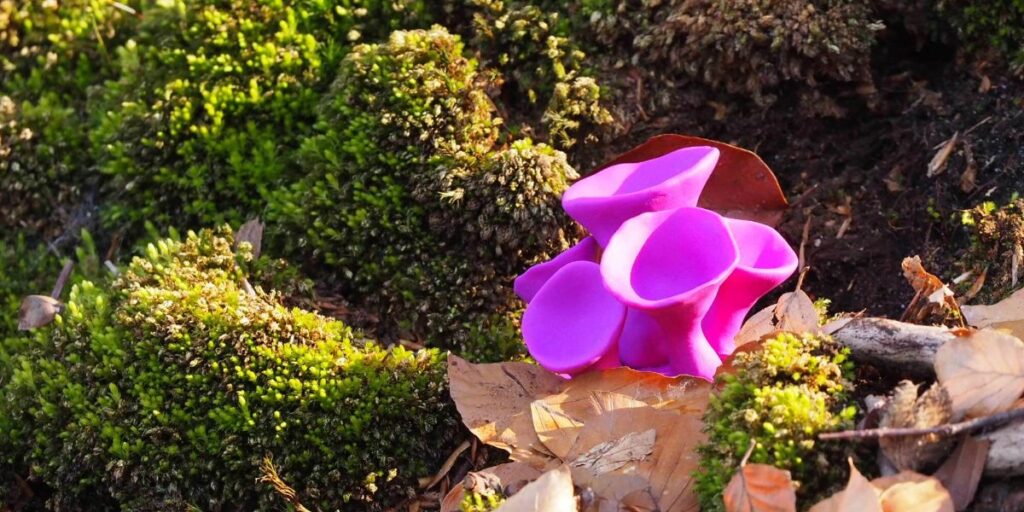Palaeoplasticene addresses the breakdown of plastic in the environment over a more-than-human timeframe. Addressing the ubiquity and longevity of microplastic in the environment, Palaeoplasticene is both a multimedia installation and an online Open Artistic Research Platform presenting series of distributed transdisciplinary experiments that question the agency of plastic through “Long Time”.
Palaeoplasticene’s concept was developed in collaboration with Studio Austen’s scientists-in-residence Indrė Žliobaitė and Laurence Gill as part of the Studiotopia programme, hosted by Ars Electronica.

Concept
Recent research has shown the presence of microplastics at the outskirts of human reach: at the bottom of the Mariana trench and on top of mountains. What we consider to be our natural environment unequivocally and ubiquitously contains plastic. The situation is such that the phrase “plastisphere” has been coined to denote the contemporary pervasive dispersal of artificial plastics around the globe. Designed to be durable and unreactive, plastic outlasts its surrounding flora and fauna, yet ecosystems are already adapting to this new materiality with microorganisms evolving to feed on plastic, and plants being shown to take microplastics into tissue.
This new materiality raises questions about “Long Time” – timescales so big that they are beyond human experience. We encounter time-scales beyond our reach through the ramifications of plastics’ release in the environment, and also through geological processes such as weathering, rock formation, the hydrological and carbon cycles. Palaeoplasticene presents a speculative past where plastic was introduced into the environment in pre-history, and by fungi rather than humans. The transdisciplinary team behind the project developed and carried out distributed experiments around Europe exploring the durability and presence of plastic in the environment, a unique synthesis of elements drawn from their individual practices. These artistic research processes underpin the project and are shared openly online for a participatory engagement with the longevity of plastic compared to other bio and geological processes.
Developed through the Studiotopia programme, Palaeoplasticene is a collaborative art and science project between data scientist Indrė Žliobaitė, environmental engineer Laurence Gill and artist Kat Austen.
Outputs
Installation
Installations inspired by the research propose a speculative past where plastic-based fungi evolved, introducing plastic to the ecosystem in pre-human history.
The sculptural installation, which includes a soundscape drawing on the passing of time and decay, includes a triptych of interactions between plastic and non-human entities, including crystals, trees and fungi.
The fungi from Palaeoplasticene’s research can be replicated using 3D printing and used to create site-specific installations “Time to Break Down: Echoes of the Palaeoplasticene”.
Open Artistic Research Platform
The team developed methods which are presented on the Palaeoplasticene Open Artistic Research Platform to explore these topics across their different European locations. The Open Artistic Research Platform, one of the project’s main outputs, is a comprehensive guide to engaging in the artistic research methods developed for the project. It has been developed as a commitment to, and adaptation of, the Open Science methods. The platform and project overall highlights the value of artistic research in reimagining environmental issues, raising new questions and providing as a response new perspectives and innovative thinking, working with science and other disciplines to forge new research paths.
The platform in exhibition form serves the purpose to showcase experimental results from the project collaborators, alongside an installation that brings to life the speculative past proposed by the project, visually referencing the platform experiments to synthesise the learning gleaned from their undertaking. The printable 3D image of the iconic Palaeoplasticene fungi can be downloaded and replicated not only for execution of the project’s taphonomy experiments but also for site-specific installations.
About STUDIOTOPIA
Kat Austen was one of the artists hosting scientists in residence as part of the STUDIOTOPIA programme, through Ars Electronica. Austen’s Studio is hosting Indrė Zliobaitė and Laurence Gill. Studiotopia’s residency, exhibition, art and pop-up lab programme aims to establish better connections between arts and science, cultural & research institutions and with European citizens.
STUDIOTOPIA is a European initiative that seeks to activate the collaborative and interdisciplinary expertise required to face the ecological implications of the Anthropocene. It consists of eight European cultural institutions: Center for Fine Arts (BOZAR) and GLUON in Brussels, Ars Electronica in Linz, Cluj Cultural Centre in Cluj, Laznia Centre for Contemporary Art in Gdansk, Onassis Cultural Centre in Athens, Vrije Universiteit Amsterdam and Laboral in Gijon.
Artists Host Scientists
STUDIOTOPIA implements an inverse art and science residency model where scientists from diverse disciplines respond to an open call to work alongside and learn from leading European artists. The aim of the residency programme is to create an experimental space where scientists and artists can exchange ideas, learn from each other, develop methods for transdisciplinary collaboration and create speculative solutions to sustainable development. The purpose of the programme is also to formulate a clearer understanding of how artists and scientists can work together, and how such interactions can contribute to achieving the UN Sustainable Development Goals.
Ars Electronica nominated the artists Kat Austen and Maja Smrekar to host selected scientists-in-residence.
Meet the Scientists

Indrė Žliobaitė is a tenure track professor at the University of Helsinki, Finland. Her background is in machine learning with evolving data. In Helsinki, she leads a research group called Data science and evolution, which focuses on computational analyses of the changing world. For the last six years, Indrė has been actively involved in evolutionary paleontology research studying the mammalian fossil record.

Laurence Gill is a Professor in Environmental Engineering in the School of Engineering, Trinity College Dublin. His research interests involve studying the fate and transport of both air and water-borne pollutants in the natural and built environment, the development of passive treatment processes, the ecohydrology of wetlands and the characterisation of karst hydrological catchments. Much of the work involves extensive field studies which are then used to develop mathematical models to gain further insight into the processes.
